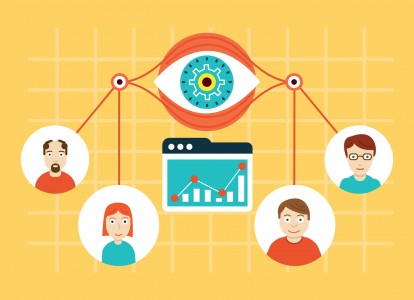
How to Cater Your Site to Your Buyers Journey
When you fill up your website with useful and amusing content, chances are it will draw a lot of traffic. But, if it doesn’t actually convert visitors to leads and then turn them into paying and loyal customers, you'll be missing out on a great opportunity. In order to attract more visitors that become customers, it is essential to know how to cater your site to your buyers journey.
Know your target buyers before you start catering your site
 The secret of attracting online visitors that turn into paying customers is great, valuable content. This is a magical magnet that attracts the attention of prospects, inviting them to come to you and make a purchase.
The secret of attracting online visitors that turn into paying customers is great, valuable content. This is a magical magnet that attracts the attention of prospects, inviting them to come to you and make a purchase.
When creating great content, it is crucial to determine precisely who you are creating it for, as what may be great for one person may be boring to others.
Do thorough research and create buyer personas. It will help you understand the needs, desires, and pain points of your most valuable customers. Once you clearly define your target audience, you’re ready to start catering your site to your buyers journey.
The buyers journey is the process that each potential buyer goes through. This process may include certain issues or challenges your buyers may experience. The main point is to identify and solve these challenges through better understanding of the stages that each buyer journey consists of.
Cater your site effectively for each stage of your buyers journey
When you want to cater your website to the buyer journey, you should always consider the three main stages: the awareness stage, the consideration stage, and the decision stage. Each stage is an important part of this journey. Therefore, understanding all three is crucial in the process of crafting your site to effectively guide visitors along this journey. In order to lead your potential customers towards making a purchase, it is essential to create valuable, targeted content for each of the three stages.
Awareness
The stage of awareness is the part of the process when an individual experiences an issue that needs to be solved. The first thing they do is conduct online research to learn more about the issue and hopefully find an adequate solution.
SEO plays a major role in the stage of awareness, as your average person today always goes and asks the search engines "how do I solve this issue I have?". Even though they're not doing this "consciously", what they're doing is effectively inputting keywords into Google. An effective SEO strategy would make sure that you rank well for those keywords.
Bonus tip 1: consider including keywords like improve, prevent and troubleshoot in your relevant educational content in the form of blog posts/articles, research reports, or eGuides.
Bonus tip 2: consider creating FAQ pages where each "question" is an issue that your potential customer might ask. Something like "Q: How do I lose weight faster"... with the answer being content that takes them further into the consideration stage and the solutions that you offer. (obviously if you're not selling a weight-loss product, substitute example)
Consideration
 What follows after awareness is the consideration stage. At this point, individuals have precisely defined their issue and are searching for the most suitable solution. Now, they learn their options and alternatives, which leads them to the next stage – decision making.
What follows after awareness is the consideration stage. At this point, individuals have precisely defined their issue and are searching for the most suitable solution. Now, they learn their options and alternatives, which leads them to the next stage – decision making.
In the stage of consideration, your potential buyers compare the relevant solutions they have found while searching online. At this point, it is good to consider including content such as video guides, product comparison lists, etc.
Remember that the decision stage is only a step away, so it is important to offer content that will keep your prospect’s attention. Offering relevant and valuable content will most likely draw them into making a purchase. In addition, consider using keywords like tool, service, appliance, etc.
Decision
As the prospects learn and evaluate possible solutions, they are deciding on an option that suits them best. At the decision stage, as your potential buyers are evaluating their purchase intention, it’s crucial to offer them content that will encourage them to buy.
To help the buyers make a decision in your favor, you should consider including case studies, positive customer reviews/testimonials and limited-time discounts. You should also include keywords such as review, test, pros and cons, compare, etc.
Get the most out of customer philosophy
With a proper strategy, you can get the most out of customer philosophy if you can cater to the modern potential customers. In order to achieve this, here are a few valuable tips that will help you improve your communication with potential paying customers.
1. Create objective content in the form of buyer guides
When people start researching a product or service, they usually consult buyer guides for a neutral opinion. While a good buyer guide is unbiased, they do cater to the strong points of the business that creates them. Therefore, having such a guide on your site, available for all visitors, is more than just a useful tool to attract potential customers. It keeps them interested and encourages them to make a decision.
2. Personalize communication whenever possible
Nothing can help you cater your business site to the buyers journey like personalized communication. Using marketing automation, you can determine your customers' behavior and interests, and develop business relations that encourage them to purchase your products or services. Once you learn their interests, you can use the most relevant content they will be interested in and create valuable relations through automated personalization.
3. Case studies and customer testimonials
Case studies and customer testimonials are highly valuable content which you can share with your potential customers throughout their buyers journey. While case studies may refer to certain real-life situations or imagined circumstances, customer testimonials are usually perceived as being true accounts. They provide a candid overview of your offerings and are a powerful persuasive tool. Therefore, having case studies and customer testimonials available on your website is crucial.
4. Focus on building trust by providing guidance
Most businesses and marketers put their main focus on the decision stage. Even though it’s the last stage of the buyers journey, it takes more than a phrase to persuade a person to make a purchase. So, instead of using Buy This Product at the decision-making stage, it’s always better to guide and encourage your customer during the entire buyer journey. It guarantees long-term success due to the gradual trust-building experience.
Again, remember that understanding your customer at each stage of the buyers journey helps you better cater your site to said journey and therefore increase profits. Knowing your target audience will help you craft useful, relevant content, effective SEO strategies, effective keywords, and customer guides and reviews.
You can have the best products and services in your industry, but if you don’t present them properly, you’ll miss out on the big bucks. Focus your site on the buyers and you’ll be amazed by the ROI it will bring.
I help businesses and marketers build marketing and sales systems that drive leads and scale with ease.
Not sure where to start? Take my marketing quiz and get personalized next steps.



